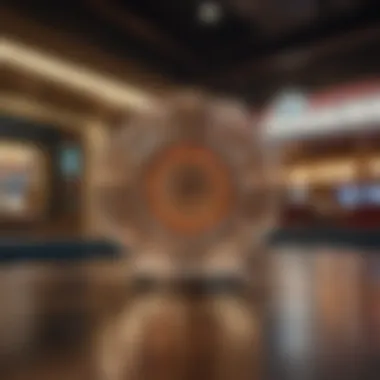Mirage Construction in Las Vegas: Art and Engineering


Intro
Las Vegas has long been known for its glitz, glamour, and, most notably, its innovative architecture. At the heart of this architectural landscape lies the concept of mirage construction. More than just visually striking buildings, these structures encapsulate the aspirations, dreams, and even the delusions of a city built on entertainment and allure.
In this exploration, we delve into the artistry and engineering behind some of Las Vegas's most iconic landmarks. From the grandiose hotels like the Venetian to the daring designs of the Wynn, each mirage constructed can be seen as a narrative woven into the fabric of the city.
Unique to Las Vegas, these constructions are not simply about aesthetics. They're a blend of culture, socio-economic factors, and historical contexts that reflect the evolving identity of a city that thrives on transformation.
As we journey through this article, you'll discover how the intricate elements of mirage construction face a unique set of challenges and blessings. We’ll unpack how these designs influence the community around them, discuss architectural trends, and contemplate the future of builds in a city that's constantly reinventing itself.
Embracing the colorful and often chaotic history of Las Vegas, we invite you to explore this dazzling dance between reality and illusion that defines the city in ways that go beyond the ordinary.
Understanding Mirage Construction: A Conceptual Overview
Mirage construction in Las Vegas is not just a catchphrase or a trendy architectural concept; it represents a unique interplay of art, engineering, and cultural reflection. It stands at the crossroad of illusion and reality, offering tourists more than mere buildings—they provide experiences, memories, and a sense of place. The essence of mirage construction resides in its ability to craft environments that stimulate senses while challenging notions of what is real and what is an illusion.
Defining Mirage Construction
Mirage construction can be defined as the architectural practice of creating structures that blend beauty with escapism, aiming to evoke awe and fascination among observers. These buildings often incorporate elements of fantasy and grandeur, designed not only to shelter but to captivate. The art lies in their presentation; whether it’s the shimmering facades of casinos or the enchanting designs of themed hotels, mirage structures transport visitors to alternate realities. For instance, stepping into the Venetian feels like wandering through the canals of Venice, complete with gondolas and striking architecture, all nestled in the heart of the Nevada desert.
A significant aspect of mirage construction is its reliance on optics and psychology. The strategically placed glass facades reflect light in such a way that they almost dance in the sunlight, creating reflections that can mislead or confuse the viewer. This clever manipulation of design not only enhances the aesthetic appeal but also showcases the ingenuity of architects and builders who strive to bring fantasy to life in a city that thrives on dreams.
Historical Context of Mirage Structures
To truly grasp the phenomenon of mirage construction, one must look back at the history of Las Vegas and its ever-evolving architectural landscape. Originally, Las Vegas was a modest railroad town, but with the advent of legalized gambling in the 1930s, it transformed into a bustling oasis of entertainment. The 1950s and '60s saw a construction boom, with hotels and casinos emerging that reflected the glitz and glamour of the era. These structures weren’t just functional; they were statements of exuberance, infused with cultural references and thematic designs.
As the years passed, architects began pushing the envelope even further. The Mirage Hotel, opened in 1989, marked a turning point in this evolution, featuring a volcano that erupts with fire and a tropical garden that feels worlds apart from the surrounding desert. This innovative approach to themed environments became hallmark of what we now refer to as mirage construction.
Looking to the future, the historical context of these structures sheds light on current trends and techniques. Facilities that once relied on extravagant designs are now balancing their artistic endeavors with considerations of sustainability and environmentally friendly practices. The evolution of mirage construction not only highlights architectural brilliance but also reflects shifts in societal values and expectations, making it a fascinating subject of study.
"In architecture, as in other forms of art, the most profound aspects are often born from the desire to transcend reality."
As we continue to explore the intricate world of mirage construction, one can appreciate that it is not merely a product of the past but a dynamic expression of culture, engineering prowess, and artistic vision that will further evolve in the years to come.
In summary, understanding mirage construction gives insights into how Las Vegas has built its identity, and why these structures continue to draw millions. They are more than walls and roofs; they are tangible dreams sewn into the fabric of this lively city.
Architectural Influences in Las Vegas
Las Vegas stands as a testament to the influence of architecture on cultural identity and societal expectations. The structures that define this desert oasis are not just buildings; they serve as reflections of the city’s dynamic ethos, intertwining with influences from various artistic movements and a relentless pursuit of entertainment. By exploring this section, readers can gain insights into how architectural decisions are intertwined with postmodernism and the ever-present entertainment industry.
Postmodernism: Reflection and Identity
Postmodernism in Las Vegas has evolved into an architectural style that defies the minimalistic norms of modernism, breathing life into buildings and spaces that speak to the city's lively spirit. This style is characterized by a playful mix of historical references, eclectic designs, and bold statements that reflect the complex nature of urban life. Instead of creating a unified architectural language, Las Vegas showcases a variety of styles where previous eras collide with contemporary flair.
For instance, the juxtaposition seen at The Venetian reflects influences from Italian architecture, adorned with gondolas and bridges, all within a landscape that thrives on artifice. This blend invites visitors to indulge in a fantasy that is far from the arid reality of the desert surroundings.
Moreover, postmodernist ideas revolve around identity, challenging conventional narratives. In Vegas, architecture doesn’t merely serve functional purposes; it crafts a narrative. Think of each structure as a chapter in a larger story, one that communicates wealth, success, and escapism. This relationship between architecture and identity is what keeps the city relevant and intriguing to both residents and tourists alike.
The Role of Entertainment in Architectural Design
Las Vegas thrives off entertainment; it is the lifeblood that fuels the bustling economy. Architectural design, therefore, is not only about aesthetics but also about creating experiences that wow and engage. Every design choice, from the towering façade of the Stratosphere to the mesmerizing water features of the Bellagio, is driven by the desire to captivate the senses.


The architecture of Las Vegas embodies an invitation, luring guests into a world of adventure and thrill. Each building functions almost like a stage set, prepared to deliver grand performances that appeal to a varied audience.
Consider the following aspects that showcase the synergy between entertainment and architecture in Las Vegas:
- Visual Appeal: Colorful and elaborate designs are meant to catch the eyes of passersby, making them feel like they stepped into a scene from a movie.
- Interactive Spaces: Areas within large facilities, like casinos, are designed to encourage social interaction, fostering an atmosphere of connection and engagement.
- Immersive Environments: Themes that transport visitors to different parts of the world or even to fantastical realms elevate the overall experience.
"In Las Vegas, architecture is an experience, not just a structure."
Key Characteristics of Mirage Structures
Understanding the key characteristics of mirage structures is crucial for grasping their role in Las Vegas's architectural scene. These buildings are not just facades hiding spaces behind them; they embody a complex blend of illusion, functionality, and artistry. In this fiercely competitive environment of entertainment and hospitality, the characteristics of these structures help define their economic viability and cultural impact.
Illusion and Reality: Finding the Balance
One of the most striking aspects of mirage construction is its inherent tension between illusion and reality. These structures are designed to manifest a fantasy while providing genuine experiences. This balancing act is not merely a visual trick; it extends to both the visitors’ expectations and the hotels’ operational needs.
For example, the design of the Mirage Hotel was crafted to mimic the beauty of a tropical paradise. Guests stepping through the doors are treated to lush landscaping, waterfalls, and exotic wildlife, creating an atmosphere of escapism. Yet, within this fabric of illusion lies a well-organized system of architectural and mechanical elements that ensure the building functions seamlessly. While visitors may feel as if they are on a remote island, they are simultaneously enjoying modern amenities that make their stay comfortable.
It’s essential to recognize how these illusions serve as a draw for patrons. The design creates narrative zones — spaces that tell a story, leading guests down a path of discovery. However, maintaining a line between what is fake and what is real also requires careful consideration. A miscalculation can lead to a breakdown in the experience, reminding guests that they’re still in the heart of the desert and not in a lush oasis.
"A building must balance between reality and fantasy to create an engaging experience for its occupants."
This begs the question: how do architects create these illusions while sticking to safety regulations and budgetary constraints? The answer lies in a meticulous selection of materials, as well as innovative design choices that enhance the overall experience.
Materials and Techniques in Mirage Construction
When discussing materials and techniques in mirage construction, it’s important to highlight how they contribute to the elaboration of illusion. The choice of materials often pushes the boundaries of what can be done in architectural design.
- Glass and Reflective Surfaces: Many mirage structures extensively use glass to create a dialogue between inside and outside, blurring the lines of perception. This can lead to visual effects that further the illusion, such as buildings seemingly floating or blending with the sky. The reflective characteristics contribute greatly to making structures look ethereal.
- Theatrical Lighting: Lighting plays a significant role in enhancing the overall aesthetic. For example, dynamic LED systems can change the feel of spaces from comforting to energizing based on the time of day or event occurring. A well-lit room can transform dramatically with shifts in color and intensity.
- Mixed Media and Textures: Using various materials, from stone to synthetic fabrics, can also create contrast that evokes specific emotions. Structural elements that feel natural and organic juxtaposed with modern, sleek finishes can forge an experience that is memorable.
While the techniques used in these constructions can be advanced, the essence remains simple: they create environments where escapism isn’t merely encouraged; it’s an experience that unfolds naturally. As Las Vegas continues to evolve, understanding these characteristics of mirage construction becomes less about simple aesthetics and more about how these structures facilitate experiences that keep people coming back.
In summary, mirage structures are a labor of love, weaving together elements of illusion, advanced materials, and techniques that serve multi-dimensional purposes. They not only attract tourists but also underscore the cultural narrative that Las Vegas continues to craft.
Examining Iconic Mirage Structures
Diving into iconic mirage structures takes us to the heart of Las Vegas where the lines between creativity and reality often blur. These sites do more than just entertain; they embody a unique approach to architectural design that blends artistic vision with consumerism.
The importance of studying these structures lies in their role as cultural landmarks that define not only the skyline but also the identity of Las Vegas. Each building tells a story, captures a moment in time, and reflects broader societal trends. The structures discussed below—The Mirage Hotel, The Venetian, and The Bellagio—are prime examples of how mirage architecture shapes visitor experiences while driving economic vitality in the region.
The Mirage Hotel: A Case Study
The Mirage Hotel announces itself like a beacon as you approach the Las Vegas Strip. Opened in 1989, it was one of the first to disrupt the then-dominant motel style, offering a lush tropical paradise in the desert.
Key Features:
- Volcano Show: An extravagant display that draws attendees to its illuminated explosion near the entrance is instrumental in creating engaging experiences.
- Tropical Theme: Inside, the lobby is graced with a rainforest atrium, adorned with exotic birds and waterfalls that evoke feelings of escape.
Exploring these features highlights the hotel’s pioneering approach in mirage construction. By merging spectacle with hospitality, The Mirage set a precedent for future developments in the city, showing how thematic elements could create immersive guest experiences.
The Venetian: Crafting a New Memory


The Venetian offers a slice of Venice, Italy, with its winding canals and gondolas. Opening its doors in 1999, this property took the concept of mirage to new heights, bringing a clear cultural motif from overseas to the Nevada desert.
What Stands Out:
- Gondola Rides: Visitors can take rides down faux canals while serenaded by gondoliers, making it feel as if they’ve actually traveled to Italy.
- Artistic Detail: The architecture features replicas of iconic Venetian landmarks, such as the Campanile, and art installations that remind one of the city’s rich history and culture.
This meticulous attention to detail not only adds to the charm but also fosters a unique memory that visitors carry home. The Venetian succeeds in creating an illusion that feels tangible, making it a critical chapter in the narrative of mirage construction in Las Vegas.
The Bellagio: Design and Experience
The Bellagio is perhaps the embodiment of luxury in Las Vegas. Renowned for its stunning fountain show, it debuted in 1998, rapidly earning the status of a world-class destination.
Distinctive Aspects:
- Fountains: Dancers in water paired with music creates an awe-inspiring spectacle that captivates guests and passersby alike.
- Conservatory & Botanical Gardens: This area undergoes seasonal transformations, showcasing breathtaking designs that reflect nature, coupled with a dose of artistry.
The Bellagio illustrates the synergy between design and experience, emphasizing how mirage architecture can elevate an otherwise ephemeral visit into a lasting memory. One can assert the design choices here are not merely for aesthetic appeal but enhance the overall emotional experience of being in Las Vegas.
"In mirage construction, the line between illusion and reality is where the true magic happens. Each landmark tells a story, enhancing the allure of Las Vegas with its mosaic of experiences."
Analyzing these structures reveals how mirage construction not only influences tourism but also acts as a cultural canvas that reflects and shapes visitor expectations. Each property adds an essential piece to the intricate puzzle, generating economic opportunities and transforming artificial environments into unforgettable destinations.
The Cultural Impact of Mirage Construction
Mirage construction in Las Vegas is not just an architectural endeavor; it plays a significant role in shaping the cultural landscape of the city. The city thrives on its image as a playground for adults, a hub of distraction, indulgence, and the fantastical. The buildings that evoke the mirage effect are often tied deeply to local identity and social dynamics. They reflect desires, dreams, and at times, the stark contrasts of reality within a society that entertains the idea of escapism.
One of the fascinating aspects of mirage construction is its ability to serve as a mirror to societal values. Each structure, from the over-the-top opulence of The Venetian to the serene beauty of The Bellagio's fountains, embodies a slice of culture, desires, and aspirations of the people who flock to Las Vegas. It draws from a mix of history, modernity, and elements that speak to human emotion, capturing the essence of what it means to pursue happiness.
"Las Vegas is a city of contrasts, where the glimmering lights of mirage structures reflect not only the riches but also the deeper dreams of its visitors."
This cultural reflection raises intriguing questions about authenticity in a place where spectacle reigns supreme. Are these structures reall representations of culture, or do they create an illusion far removed from the genuine experiences of everyday life? As we dive into the elements of mirage architecture as a reflection of society, we uncover complexities that intertwine the fabric of Las Vegas.
Mirage Architecture as a Reflection of Society
The relationship between mirage architecture and societal values is nuanced and complex. Structures like the Luxor Pyramid and New York-New York evoke strong imagery and emotions, allowing guests to engage with multiple facets of culture without ever leaving the Strip. It’s as if each building tells its own story, shaped by diverse influences:
- Historical Practices: The design of the mirage structures often cites global influences, allowing visitors to feel echoes of ancient civilizations or contemporary societies.
- Tourism as Culture: With millions flocking to the city for short vacations, these architectural marvels cater to the thrill-seeker and the wanderer alike.
- Escapism: Mirage structures promise a temporary escape from reality. This goes beyond mere entertainment; it speaks to human emotions and the longing for adventure.
Every brick laid in these constructions isn’t just for aesthetic appeal but symbolizes a yearning for something greater, a quest for belonging wrapped in the glitzy allure of Las Vegas.
Tourist Expectations and Realities
When visitors arrive in Las Vegas, they often carry a set of expectations shaped by persuasive marketing, social media, and pop culture. The city is painted as an urban oasis of extravagance and debauchery — a place where dreams manifest in the form of gambling wins and glittering lights. However, the experience can sometimes diverge significantly from these anticipations.
The underlying reality is multi-faceted:
- Diverse Experiences: Not everyone finds joy in high-stakes poker games or late-night clubbing. Family-friendly attractions and quieter venues often give a different vibe to the experience of Las Vegas.
- Economic Disparities: The glitzy facade can obscure the reality of those who work in the service industry, navigating the divide between affluence and hardship.
- Sustainability Concerns: As tourists chase the mirage of luxury, the environmental impacts of such constructions and the related waste are becoming an inconvenient truth.
The interplay between expectations and reality is crucial. Mirage construction embodies a dream yet also invites visitors to engage with the paradoxes of a vibrant city, thus framing Las Vegas both as a fantasy land and a complex social environment.
Economic Implications of Mirage Structures


The interplay between mirage construction and the economy in Las Vegas is no simple matter. Mirage structures are not just visual spectacles; they are critical economic drivers. This subsection reveals how the unique architectural concepts that define this vibrant city influence both local and broader economies. Through understanding these implications, we shed light on how these architectural marvels contribute to job creation, tourism, and ultimately, the economic fabric of Las Vegas.
Cost-Benefit Analysis of Mirage Construction
When considering the financial aspects of mirage construction, a detailed cost-benefit analysis is essential. The initial investments in building these intricate structures are steep. For instance, the cost of designing and constructing a mirage hotel can soar into the hundreds of millions of dollars. Yet, the returns can be equally significant.
- Investment Costs: From the initial blueprint stage, construction materials, labor, and technology, the expenditure can be hefty. Companies like MGM Resorts and Caesars Entertainment have made bold commitments to sustainable and innovative design, often resulting in higher initial prices.
- Long-Term Profits: Once established, these structures can attract thousands of visitors each year. The Mirage Hotel or The Venetian not only serve as accommodations but also house casinos, dining, and entertainment options. This multi-faceted approach creates diverse revenue streams.
Moreover, looking beyond the obvious financial returns, these structures help maintain Las Vegas's allure. They become attractions in their own right, contributing to an overall increase in tourism. It's a cycle of investment that feeds and grows itself. Notably, increased tourism translates to more tax revenue for the state.
Revenue Generation through Mirage Attractions
The revenue generation capabilities of mirage attractions is staggering. These structures aren’t just places to stay; they create experiences that beckon millions each year.
- Gaming Revenue: Casinos within these mirage structures are a primary source of income. For instance, The Bellagio operates a lucrative gaming floor that pulls in poker enthusiasts and casual players alike. The unique offerings of each casino, whether it’s a themed poker room or high-stakes tables, attract a diverse clientele willing to spend.
- Entertainment Offerings: Shows and events are another big ticket. Cirque du Soleil’s "O" at the Bellagio or the enchanting fountains provide entertainment that can only be found in Las Vegas. They draw in audiences that may not gamble but are eager to experience the city's offerings.
- Dining and Retail: Restaurants helmed by celebrity chefs and luxury retail spaces within these hotels further bolster revenue. The Venetian, for example, features high-end options like Mario Batali's B&B, catering to those seeking a gourmet experience. Consumers are drawn to these spots, added spending translating directly into increased revenue for the properties.
To sum it up, mirage structures significantly uplift the economy of Las Vegas. They provide jobs, enhance tourism, and offer unique experiences that serve as magnets for visitors. It’s this intricate dance between architectural design and economic vitality that underscores the importance of mirage construction in a city like Las Vegas.
Future Trends in Mirage Construction
As Las Vegas continues to evolve, so too does its architectural landscape. The future trends in mirage construction are pivotal for both the city’s reputation and its economic health. With a growing emphasis on sustainability and technological innovation, these movements shape the essence of new developments. Understanding these trends is vital, not just for architects and investors, but also for visitors eagerly anticipating the next big spectacle in this desert oasis.
Sustainability in Mirage Design
The pressing issue of sustainability has seeped into the construction vernacular of Las Vegas. Developers now face the challenge of creating mirage structures that are not just visually stunning but also environmentally responsible. This movement isn’t merely a trend but rather a necessity driven by market demand and legislative pressures.
- Use of Sustainable Materials: Architects are increasingly incorporating local and recycled materials. This reduces the carbon footprint that comes with transportation and promotes the local economy. For example, some establishments are using reclaimed wood and recycled glass in their designs.
- Energy Efficiency: Innovations such as energy-efficient HVAC systems, solar panel integration, and landscaping that promotes reduced water usage are vital in these designs. The Mirage Hotel, for instance, has made strides in energy conservation, showcasing this commitment to sustainability.
- Eco-friendly Practices: The rise of green certifications like LEED-Leadership in Energy and Environmental Design is prompting developers to pursue environmentally sound practices throughout the construction phase. This can mean anything from waste reduction in building processes to securing habitat preservation permits.
In essence, embracing sustainability not only enhances the aesthetic appeal of a building but also aligns with the values of an increasingly environmentally-conscious public. It is essential for businesses to recognize that consumers are drawn to companies that demonstrate environmental responsibility, which ultimately influences their choices when visiting Las Vegas.
Technological Advancements Shaping Mirage Construction
Technology has ushered in fresh possibilities in the arena of mirage construction. Many architects and builders are now leveraging cutting-edge advancements that blend artistry with innovative engineering to create iconic structures. Here are some examples of how technology reshapes the landscape:
- Virtual and Augmented Reality: Before laying a single brick, architects can now use virtual and augmented reality to create 3D models of their designs, giving potential investors and stakeholders a vivid preview. This ability to visualize the structure before its completion enhances collaboration and helps in fine-tuning designs to perfection.
- Smart Building Technologies: Integrating technology is becoming less of a choice and more of a requirement. Features like building management systems automate lighting, heating, and air conditioning, enhancing guest comfort while reducing energy consumption. Buildings like the Venetian leverage these systems to offer guests a seamless experience, marrying comfort and efficiency.
- Advanced Construction Techniques: From 3D printing components to modular construction, the methodologies that define mirage structures are rapidly advancing. These innovative methods not only cut down on construction times but also allow for more intricate designs that would have once seemed impossible due to traditional building constraints.
"With an eye towards the future, architects are not only building structures but also crafting experiences that are tailored to the aspirations of a new generation of visitors."
The trend is clear—technology is not just supporting the construction but is actually redefining what’s possible. Emerging trends in smart technology and sustainability will determine the future of important structures in Las Vegas and solidify the city’s role as a leader in architectural innovation for years to come.
In closing, the interplay of sustainability and technology is shaping a new narrative for mirage construction. As both locals and tourists find more interconnected experiences in Las Vegas, the influence of these trends can not be overstated.
Culmination: The Enduring Allure of Mirage Construction
The end of this exploration into mirage construction leaves us with a profound appreciation for the artistry and thought behind the iconic structures that pepper Las Vegas. These buildings are not simply concrete and glass but rather reflections of cultural aspirations, economic realities, and aesthetic innovation. They merge creativity with function, crafting experiences that resonate deeply with visitors from all walks of life.
Importance of Mirage Construction
Mirage construction plays a critical role in shaping the identity of Las Vegas. Each structure, from The Mirage Hotel’s famous volcano to The Venetian’s intricate canals, invites tourists to step into a world where reality often blurs into fantasy. This phenomenon generates not just excitement but also a powerful emotional connection. People come to Vegas not just to gamble, but to live the spectacle. They seek unforgettable experiences—moments that make them feel alive.
Cultural Relevance
Every mirage structure serves as a canvas, projecting society's values and aspirations. They illustrate the American spirit's relentless pursuit of more, encapsulating dreams in towering facades. These buildings often draw on nostalgia and cultural references, resonating with visitors in a way that feels both personal and expansive. This cultural narrative is a core reason why mirage construction remains alluring. It speaks to something deeper, something intrinsic to the human experience—the desire to escape and to immerse oneself in wonder.
Economic Considerations
In terms of the bottom line, mirage structures contribute significantly to Las Vegas's economy. They attract millions of tourists annually, generating revenue through hospitality, dining, and entertainment. They also create a ripple effect�—employment opportunities, investment in local businesses, and enhanced city branding. The allure of mirage construction is not only aesthetic but practical, driving the economic engine of one of the world's most vibrant cities.
Final Thoughts
Looking ahead, mirage construction in Las Vegas is likely to evolve, influenced by technology and sustainability trends. However, the core allure will remain—crafting illusions that enchant and inspire. The interplay of art and architecture will continue to redefine what we perceive as possible, inviting future generations to dream just as those before them have. The enduring allure of mirage construction lies in its ability to blend reality with imagination, leaving a lasting impact on all who experience it.
"Las Vegas is a city defined by its fantasies. Mirages come alive in these structures, reminding us that sometimes, the line between our aspirations and reality can be beautifully blurred."
As we reflect on the findings presented in this article, it becomes clear that the marvel of Las Vegas’s architecture is as much about its cultural essence as it is about the structures themselves. It’s a rich narrative worth exploring, one that captivates not only the eye but also the heart and mind.















